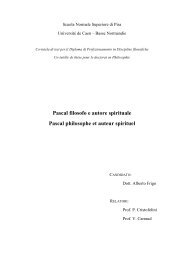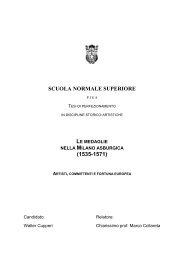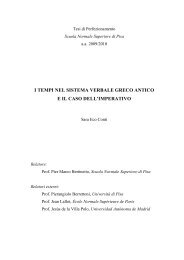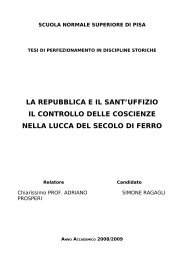CATULLUS 68 - Scuola Normale Superiore
CATULLUS 68 - Scuola Normale Superiore
CATULLUS 68 - Scuola Normale Superiore
Create successful ePaper yourself
Turn your PDF publications into a flip-book with our unique Google optimized e-Paper software.
108 The line is echoed by Virgil’s description of Charybdis at Aen. 3.421f. imo barathri ter gurgite uastos /<br />
sorbet in abruptum fluctus.<br />
abruptum … barathrum The Greek loan-word barathrum ‘chasm, abyss’ (not ‘gorge’) had already been<br />
used by Plautus (Bac. 149, Curc. 121 and Rud. 570) and is also found in Lucretius (6.606). Later it is found<br />
regularly, though not frequently, in poetry (Hor. 1x Sat. and 1x Epist., Verg. Aen. 2x, Colum. 1x in a verse<br />
passage, Stat. 4x, Val. Fl. 2x, Mart. 2x, Sil. 1x), and it occurs only very rarely in prose (only at Vitr. 10.16.11<br />
and 3x in Apul.). Here Catullus may be using it simply because it is the term with which Greek authors<br />
referred to the cave dug by Hercules near Pheneus (see on lines 109-116); in any case as a Greek loan-word<br />
it is well suited to the Greek myth, while its native Latin equivalents would have been less suitable: uorago<br />
would have clashed with absorbens and uertice, while Hercules could not have dug a hiatus.<br />
109-116 In an extended simile Catullus compares the depth of Laodamia’s love to that of the barathrum<br />
dug by Hercules when he hunted down the Stymphalian birds (lines 113f.).<br />
As one of his twelve labours, Hercules had to rid the town of Stymphalus in Arcadia of the pernicious birds<br />
that were infesting it. Stymphalus lies in a depression between the Arcadian mountains, as does Pheneus,<br />
lying just 15 km to the northwest. The waters that gather in the depression surrounding Pheneus are led off<br />
through at least two caves that function as natural underground channels (see Frazer 1898: 4.231-234 on<br />
Paus. 8.14.2 and especially Baker-Penoyre 1902). These unusual natural features seem to have had a<br />
prominent role in local myth: according to one story, the people of Pheneus would have noticed Pluto<br />
carrying off Core through such a channel (Conon FGH 1.15 Jacoby – note •ν δϒ τι ξ !μα ⁄ν Κυλλ→νηι),<br />
while Pausanias 8.14.2 tells another story about the shafts: τ δ′ β ραψρα ο⇓ Φενε ται τα⎝τ φα!ιν<br />
εναι ξειροπο⇔ητα, ποι°!αι δ′ α⎡τ Ηρακλϒα τηνικα⎝τα ⁄ν Φενε∩ι παρ Λαον〉μηι τ°ι<br />
Αμφιτρ⎛ϖνο! μητρ⇐ ο⇒κο⎝ντα. One should note the word β ραψρα in Pausanias’ account; according<br />
to Eratosthenes (frg. III B 105 Berger ap. Strabo 8.8.2 = p. 389 Corais) the locals called them ζϒρεψρα.<br />
Pausanias was writing two centuries after Catullus and his version of the myth must reflect what he heard in<br />
Pheneus: note the words ο⇓ Φενε ται τα⎝τ φα!ιν εναι … Catullus, on the other hand, does not appear<br />
to have travelled through rural Arcadia and must have been using a literary source. He dates the construction<br />
of the shafts to a different stage within the hero’s career than do Pausanias’ Pheneates – not to Hercules’ stay<br />
with a local woman of Pheneus, which was evidently a local legend, but to his well-known expedition<br />
against the birds infesting the nearby Stymphalus. Ellis suggests that Catullus could be following Callim.<br />
Del. 71 φε⎝γεν δ ⌡ γϒρϖν μετ〉πι!ψε Φενει〉!, but Callimachus does not say anything about the βϒρεψρα<br />
in this passage. In this case we cannot track the source of Catullus’ erudition; his reputation as a poeta doctus<br />
is well-deserved.<br />
In this passage Catullus uses elevated language; apart from the poetic vocabulary and the Grecisms one<br />
should note the strong alliteration: siccari pingue palude solum, quod quondam, montis … medullis, tempore<br />
… imperio, and so on. Hercules’ achievement calls for the high style.<br />
214






